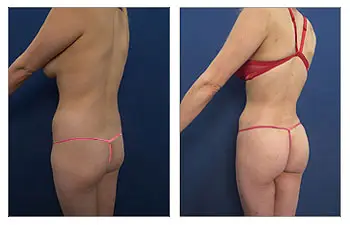

26-year-old female who had a maximized BBL while avoiding a blow out deformity
Introduction: What is a Blow Out Deformity?
What is a blow out deformity? A blow out deformity occurs when a large volume of fat is placed in a single space resulting in a bulk of fat cells that then cannot establish vascularity. Vascularity describes the inability of fat cells to reconnect to blood vessels that are needed to sustain living entities. Arteries bring in oxygen and nutrients and veins remove carbon dioxide and waste products. If vascularity is not established, then the cells die.
Blow Out Deformity: Explained
Fat cell transfer requires cells to become vascularized or otherwise face death. When a fat cell dies, it can become prone to infection. If a small volume of fat cells die, they become calcified and firm and eventually the body can remove the dead cells.
However, if there is a large volume of fat cells that die in one region, then they cannot be reabsorbed, and will subsequently create a lake of dead fat cells, coined a blow out deformity.
This lake is not only an irritant to the body but ist can get infected since the cells are not viable, which can then develop into a blow out deformity. Blow out deformity is often detected when a deformity results from fat cells that are not reabsorbed which subsequently become inflammatory and swell out.
The resulting deformity can be quite dramatic and must be treated.
So how do we avoid a blow out deformity?
Blow out deformity is avoided by utilizing several measures during the Brazilian butt lift fat transfer. First, the fat cells need to be transferred in small packs measuring no greater than 0.5cc each.
Another maneuver is to inject the fat cells from different directions so that they are not all deposited in a straight line fashion and near each other. This means using multiple port sites so that the fat cells can be cross-hatched in different directions and various planes.
Surgeons who know how to avoid blow out deformities can visualize the buttock field in a three-dimensional manner.
Whereas the fat cells need to be positioned in small aliquots they also have to be kept out of the muscle to avoid a fat embolism. This means that the fat can only be injected in a tight space between the skin and the muscle.
Using expansion vibratory lipofilling (EVL) can help increase this tight space allowing for more fat to be grafted safely. EVL is performed by using a micro vibratory cannula, called the PALS (Power Assisted Liposuction), which allows micro expansion of the soft tissue that can then accommodate a small 0.5cc of fat packages.
The final advice to patients desiring a Brazilian butt lift is to avoid overfilling with large volumes of fat transfer which is the most common cause of blow out deformity. As a general rule, avoid volumes greater than 1000cc per buttock mound cheek.
How to Correct a blow out deformity?
A blow out deformity is a technically challenging condition to correct. First, the pool of dead cells must be removed. Unfortunately, the fat cell cannot just be sucked out with a liposuction cannula and thus necessitate an incision and drainage procedure. The created cavity must also be irrigated with antibiotic solution to remove any residual dead cells and to ensure a sterile field. The final component of treating a blow out deformity is to eliminate any skin redundancy. This will typically require a formal excision of the skin redundancy.
Conclusion: What is a blow out deformity?
In summary, a blow out deformity is caused by a large bulk of grafted cells that are not able to establish blood flow resulting in fat necrosis. If the dead fat cells cannot be reabsorbed, they will form a blow out deformity. This deformity results from local irritation and often infection of dead cells. Appropriate surgical technique and being conservative with buttock volume fat grafted will help you avoid a blow out deformity. If a blow out deformity has formed, it will require surgical correction with incision and drainage as well as excision of skin redundancy.
Please see this 26-year-old female who had a maximized BBL while avoiding a blow out deformity.

